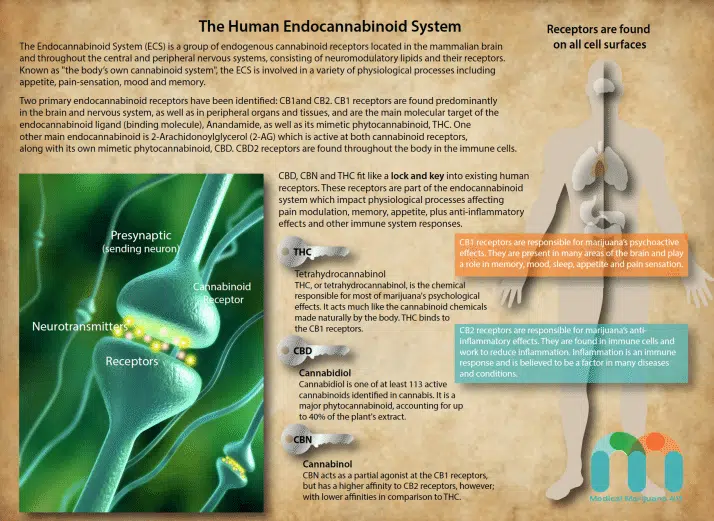The endocannabinoid system is a central regulatory system that affects a wide range of biological processes.
The endocannabinoid system consists of a group of molecules “cannabinoids” as well as the cannabinoid receptors that the cannabinoids bind to.
Although marijuana is a source of over 60 cannabinoids (including THC and CBD), the human body produces a number of cannabinoids as well which make up what is known as the Endocannabinoid System. These endogenous cannabinoids include anandamide and 2-arachidonoylglycerol (2-AG) and are present in all human beings.
Decades of scientific research on the endocannabinoid system has resulted in the discovery of two types of cannabinoid receptors, CB1 and CB2. These receptors are found in various parts of the body, but are most prominent in the brain and immune system.
Cannabinoid receptors act as binding sites for endogenous cannabinoids as well as cannabinoids found in marijuana. When cannabinoids bind to CB1 or CB2 receptors, they act to change the way the body functions.
While cannabinoid receptors are primarily expressed in the brain and immune system, researchers have identified cannabinoid receptors in a variety of other places as well, including the peripheral nervous system, cardiovascular system, reproductive system, and gastrointestinal and urinary tracts. Cannabinoid receptors continue to be identified in unique parts of the body as research on the endocannabinoid system progresses.
What Does It Do?
Interestingly, the endocannabinoid system is not unique to the human species. Rather, research has shown that this system is common to all humans and vertebrate animals – and even some invertebrate animals – suggesting its significance in the process of evolution. Experts believe that natural selection has conserved the endocannabinoid system in living organisms for 500 million years.
Although the endocannabinoid system affects a wide variety of biological processes (such as appetite and sleep), experts believe that its overall function is to regulate homeostasis.
Homeostasis is a key element in the biology of all living things and is best described as the ability to maintain stable internal conditions that are necessary for survival. Disease is simply a result of some aspect of failure in achieving homeostasis, making the endocannabinoid system a unique target for medical applications.
Medical Applications
A primary example of the endocannabinoid system’s role in homeostasis comes from research that has identified an overexpression of cannabinoid receptors in the tumor cells of various cancer diseases, including lung cancer, liver cancer, breast cancer and prostate cancer. Research has also shown that tumor growth can be inhibited and even reversed when cannabinoids such as THC are administered.
Experts believe that the overexpression of cannabinoid receptors is an indicator of the endocannabinoid system’s role as a biological defence system, providing strong support for the use of medical marijuana.
Research suggests that this defense system is not only useful in treating cancer, but may also be beneficial in the treatment of a wide variety of conditions. Current evidence points to the endocannabinoid system as being a potential therapeutic target for the following list of disorders:
- AIDS/HIV
- Alzheimer’s disease
- Arthritis
- Cancer
- Chronic pain
- Epilepsy
- Fibromyalgia
- Glaucoma
- Multiple sclerosis
- Sleep disorders
- Post-traumatic stress disorder
- And many more
NIH Review
In recent years, researchers from all parts of the world have come to acknowledge the vast medical potential of the endocannabinoid system. Summarized in a 2006 review by the National Institutes of Health (NIH):
“In the past decade, the endocannabinoid system has been implicated in a growing number of physiological functions, both in the central and peripheral nervous systems and in peripheral organs… modulating the activity of the endocannabinoid system turned out to hold therapeutic promise in a wide range of disparate diseases and pathological conditions, ranging from mood and anxiety disorders, movement disorders such as Parkinson’s and Huntington’s disease, neuropathic pain, multiple sclerosis and spinal cord injury, to cancer, atherosclerosis, myocardial infarction, stroke, hypertension, glaucoma, obesity/metabolic syndrome, and osteoporosis, to name just a few…”



